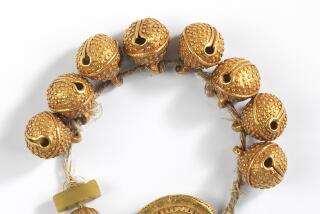Looted by Radicals : Victims of Red Guards Getting Heirlooms Back
- Share via
PEKING — An old Chinese man peered at the piles of dusty bronze bowls, ripped scroll paintings and cracked cloisonne vases, looking for something familiar from nearly two decades ago when the Red Guards came. There was nothing.
“I lost many things during the Cultural Revolution,” he said. “But I do not see them here.”
He was one of the Peking residents who ventured into a display of 30,000 items, some hundreds of years old, seized as “poisonous weeds” of the feudal past by Mao Tse-tung’s rampaging Red Guard radicals in the 1966-76 Cultural Revolution.
Screaming slogans and breaking down doors, the Red Guards forced ordinary citizens to surrender their most precious possessions in what the Chinese now call a reign of terror that has left deep scars.
Many Unclaimed
Mao’s Communist Party successors ordered the booty returned to victims after that decade, but many of the smaller items have remained unclaimed.
Borrowing an elementary school, Peking officials organized a 12-day “restitution exhibit,” which closed after 8,000 items had been returned to their rightful owners.
“It is impossible to estimate the worth of these things,” said Gao Yushan, 61, an administrator in charge of the exhibit. “Many are only valuable to those who lost them.”
Asked what will happen to the uncollected items, he said, “We will have to wait for the government directives. I do not know.”
He said about 700 people had come searching for family heirlooms. For those who claimed the same item, Gao’s staff made a final decision based on evidence each party could present.
“Many people have cried when they recognized something that was taken from them,” he said. “This is a kind of evidence.”
Destroyed Many Items
The Red Guards burned, trampled or ripped much of the loot and stored the remainder in commandeered factories, sports stadiums and churches.
A walk through the 18-room exhibit was like a glimpse into the terror of that time. A few browsers stared, apparently lost in thought. Others moved away nervously when foreigners approached.
“You are welcome to come and look,”
said a chalked message on the blackboards of each room. Another sign read: “Please handle carefully.”
Several rooms were crammed with battered, withered scrolls of delicate brush paintings and embroidered landscapes, some dating to the Ming dynasty (1368-1644).
“Many people defaced or destroyed their scrolls because they did not want the Red Guards to accuse them,” Gao said. He showed visitors a 300-year-old picture on which the owner had scrawled: “I invite the Red Guard comrades to rip this poisonous weed.”
Other rooms were piled with bronze bells, ivory carvings, brass candlesticks, silver bracelets, gold lockets and inlaid rosewood jewelry boxes, now rotted and crumbling.
Two-thirds of the items were Chinese books, falling apart from neglect and abuse, with subjects ranging from medical science to Tang dynasty poetry. There was even a volume of “On Coalition Government,” one of Mao’s early works.
“The Red Guards said reading was useless,” Gao said. “They took everything.”
More to Read
Sign up for Essential California
The most important California stories and recommendations in your inbox every morning.
You may occasionally receive promotional content from the Los Angeles Times.












